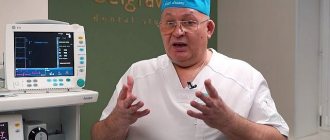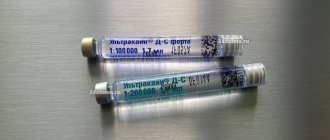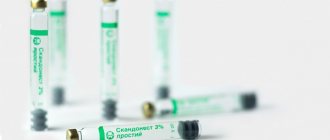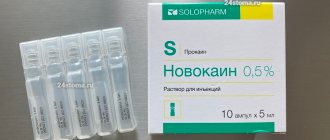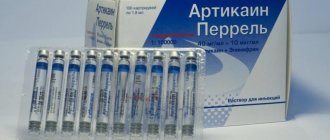Ubistezin
Ubistezin is a German drug that is produced. It contains the local anesthetic articaine and the hormone epinephrine (adrenaline), which has a vasoconstrictor effect. Vasoconstriction ensures a low degree of penetration of the drug into the blood and maximum effect at the site of use.
The drug has 2 release forms: with an epinephrine concentration of 1:200000 and 1:100000. The analgesic effect occurs within 1-3 minutes after administration. The duration of action is at least 75 minutes.
The drug is used only for anesthesia in dentistry (infiltration and conduction). It should not be administered intravenously or used in areas of inflammation.
Septanest
Septanest is an anesthetic that has been used in medical practice for quite some time. In addition to articaine and epinephrine, it contains auxiliary substances, which often cause complications of anesthesia in dentistry such as allergic reactions of patients. The drug is available in two dosage forms: with an epinephrine content of 1:100,000 and 1:200,000.
The effect of the drug appears after 1-3 minutes. Its duration is at least 45 minutes. It has good tissue tolerance and has a moderate vasoconstrictor effect.
Scandonest
What anesthesia in dentistry is suitable for patients with diabetes, thyroid diseases, an increased tendency to allergic reactions and patients with bronchial asthma? Scandonest is a drug that does not contain vasoconstrictor components or preservatives. Therefore, it is suitable for all patients at risk. For some, it is used with caution (during pregnancy, diseases of the liver, kidneys and cardiovascular system).
The anesthetic is produced on the basis of 3% mepivacaine. It provides fast, long-lasting and strong pain relief. Suitable for all types of local anesthesia.
Ultracaine
Ultracaine
– this is the best anesthesia in dentistry during pregnancy and for many diseases. It is based on articaine and is available in three forms: with a concentration of epinephrine 1:100000, 1:200000 and completely without epinephrine. The drug contains almost no preservatives. Lasts on average 2-3 hours. According to reviews from dentists and patients, ultracaine is the most potent among its analogues.
The cost of a carpule of any of the listed medications is approximately 30-50 rubles.
This article is for informational purposes only, please consult your doctor for details!
Anesthesia in dentistry - don't be afraid!
For most patients, a visit to the dentist is stressful. Every second patient is afraid to have their teeth treated, afraid of pain.
Many people still remember when anesthesia was used mainly for tooth extraction. They remember the notorious “be patient” - instead of pain relief and painful sensations during dental treatment, even with an anesthetic injection. This is explained by the fact that previously local anesthesia took effect 15 minutes after the injection, and according to the regulations, the doctor had to spend approximately this time on one patient.
Today, the treatment of dental diseases has become completely different - painless and more and more comfortable. And anesthesia plays an important role in this.
What should anesthesia be like in dentistry?
You can hear from patients at an appointment: “Give a good injection - one that doesn’t hurt.”
But pain medications vary significantly: some may not be suitable for you, others will cause swelling or an allergic reaction.
The dentist selects an anesthetic drug for the patient INDIVIDUALLY
, depending on the goals and methods of dental treatment and the condition of his body.
The method of pain relief must be effective, reasonable and safe for the patient.
Basic methods of pain relief in dentistry
1. Application anesthesia -
non-invasive, non-injection method, i.e. this is NOT an injection! A special anesthetic gel or spray is applied to the gum in the area of the diseased tooth.
Application anesthesia
very relevant in adult patients with severe dental phobia and in pediatric dentistry, since it is difficult to give an injection to a child. Such anesthesia is used before the main one so that the patient does not feel the injection itself, or for light procedures - professional hygiene, enamel grinding, etc.
2. Infiltration anesthesia
creates a “depot” of anesthetic in the area of the diseased tooth, from where it will be absorbed and give an analgesic effect.
Infiltration anesthesia is especially effective in the upper jaw, and in the lower jaw - only in the area of the front teeth.
3. Conduction anesthesia.
The essence of conduction anesthesia is to block certain nerves.
Conduction anesthesia is recommended when complex complex surgical intervention is required, when working with several teeth, in the area of inflammation, when it is necessary to remove pulp, or open an abscess.
4. Ultrasound anesthesia.
Ultrasound helps to accurately determine the location of the anesthetic injection - literally down to the millimeter, adjust the place where to insert the needle so that the injected anesthetic gets as close to the nerve as possible. This will ensure the most effective and safe anesthesia of the desired area.
5.
Intraseptal (intraseptal) and intraligamentary ( intraligamentous/and intraperiodontal) anesthesia.
These methods require special personnel skills and special equipment. The anesthetic is injected into the bone septum between the teeth or into the periodontal space. Used when other methods of pain relief are ineffective.
Treatment under anesthesia
Anesthesia in dentistry is used less frequently than local anesthesia, and is not an everyday solution, but rather an exceptional necessity when dental treatment under any other anesthesia is impossible.
Yes, the drugs used for general anesthesia are safe for the patient’s health and have minimal contraindications, but general anesthesia affects the WHOLE BODY, while local anesthesia affects only the necessary areas.
General anesthesia is indicated for:
- severe dental phobia - an insurmountable fear of treatment;
- general diseases that cause inappropriate behavior of the patient, for example, epilepsy;
- complex surgical interventions requiring very long work by the surgeon;
- allergic intolerance to all modern local anesthetics.
General anesthesia can only be used in a clinic specially equipped for this, which either has its own team of anesthesiologists, or it provides for the deployment of a visiting team, with all the necessary equipment for resuscitation.
You need to understand that it is not the anesthesia itself that is dangerous, it is the clinic’s lack of medical equipment that is dangerous, and the administration of anesthesia by unqualified medical personnel is dangerous.
The main advantage of general anesthesia for dental treatment is the reduction of treatment time. During one visit, the doctor has the opportunity to remove or treat several teeth at once.
What is sedation in dentistry?
As an alternative to general anesthesia, sedation is used in combination with local anesthesia.
.
Sedation
- this is the introduction of sedatives that immerse the patient in a light superficial sleep, helping to relax and calm down during dental treatment. Sedation is used in the treatment of both adults and children.
There are three ways to administer sedation drugs:
- inhalation
- during the entire treatment the patient inhales a soothing gas (a mixture of oxygen and nitrous oxide) through a mask; - intravenous
- injection of a drug suitable for a particular patient; - oral
- the medicine is usually dissolved in a glass of water or juice.
Sedation is not anesthesia; it is part of a complex with local anesthesia.
Indications:
- age up to three years;
- individual intolerance to drugs;
- respiratory diseases;
- neuromuscular diseases, epilepsy.
The use of nitrous oxide is contraindicated if:
- intracranial hypertension, i.e. increased pressure in the cranial cavity;
- hyperexcitability syndrome.
What is carpule anesthesia?
As a rule, modern dental clinics use carpule anesthesia
.
The anesthetic is contained in disposable carpules
- a kind of cartridges with an anesthetic solution that are inserted into syringes with disposable needles.
Advantages:
- precise dosage of anesthetic, which makes it easier to control the dose of anesthesia;
- sterility - the solution inside the capsule is sealed in compliance with aseptic standards, contact of the medicine with air is excluded, a disposable needle is used.
What drugs are used for anesthesia at the dentist?
Do you know the names of drugs used for anesthesia? Most likely, you remember Novocaine
or
lidocaine
.
By the way, novocaine is now not used in dental treatment. Many new and much safer drugs have appeared that are more effective: ultracaine, ubistezin, septonest, scandonest
.
Their analgesic effect is 5-6 times stronger.
When is anesthesia used in pediatric dentistry?
Pain relief for children is just as necessary as for adults.
It is a pure myth that children have no nerves in their baby teeth, so they cannot get sick! Considering that a child’s body is more vulnerable to all influences, selecting the correct and safe anesthesia for a child is even more responsible for the dentist.
Features of pain relief for dental treatment in elderly people
In elderly people, the use of anesthesia should be carried out taking into account the possibility of developing respiratory failure and complications from the cardiovascular system. A thorough preliminary medical history is required, including consultations with attending general practitioners.
Main contraindications to local anesthesia in dentistry
- Allergy, individual intolerance to pain-relieving components and excipients of the drug.
- Bronchial asthma, tachycardia, unstable angina, refractory arrhythmia.
- Mental abnormalities and disorders in the patient.
- Recent heart attack, stroke, heart surgery, coronary bypass surgery.
- Reduced blood clotting, including those caused by the use of anticoagulants.
- Diseases affecting the endocrine system - thyrotoxicosis, diabetes mellitus and others
- The use of antidepressants and adrenergic blockers.
- Severe liver and kidney failure.
It is not recommended to do anesthesia, and, in general, to treat teeth, on an empty stomach, when you feel unwell, in acute conditions and exacerbation of diseases.
If an allergy is suspected, the patient must undergo appropriate allergy tests.
If intolerance to all drugs for local anesthesia is detected, the patient is recommended to undergo general anesthesia.
What are the features of anesthesia in dentistry for pregnant women?
The main obstacle to dental treatment for pregnant women is anesthesia. Conventional painkillers are not suitable for them, since vasoconstrictors are usually added to the anesthetic solution. But the dentist is one of the very necessary doctors during pregnancy.
In our clinic, specialists provide pain relief using application, infiltration and conduction anesthesia.
When administering drugs by injection, we use carpule syringes.
For administration to patients, we use only certified anesthetic drugs from leading global manufacturers. We always select an anesthetic individually, so we always have a fairly wide range of anesthetics for adults.
Taking a thorough history before treatment is very important.
If there is a suspicion of a possible allergic reaction to anesthesia or the presence of any contraindications, the patient will be referred for further examination and allergy tests.
Carpule anesthesia
Carpule anesthesia is anesthesia that uses a special syringe. It is used for comfortable and safe anesthesia. In modern dentistry, this method of pain relief is considered one of the most popular. It costs more than usual, but, according to reviews, it is very easy to carry, and the process of inserting the needle is practically not felt.
Carpule syringe in dentistry
Carpule syringes in dentistry are disposable dental injectors that are equipped with a system to protect against accidental needle injury. Also, a carpule syringe has a needle, a piston part and a base body. In the side of the body there is a place for inserting a carpule.
Carpula is a special container containing an anesthetic substance. On one side of the container there is a rubber stopper, on the other there is a metal lid.
The difference between a carpule syringe and a classic one is as follows: the piston of the system cannot be removed by moving it backwards, as in conventional analogues.
The system works as follows: the desired carpule with anesthetic is placed in the syringe, a disposable carpule needle is attached, and it is inserted into the area in need of anesthesia.
Today, all leading dentists use precisely such solutions for administering anesthetics. The syringes are technically sophisticated, comfortable to use, and most importantly, the patient does not feel pain during the piercing of living tissue and the administration of anesthetic.
Pros and cons of carpule anesthesia
- allows you to accurately measure the volume of injected anesthetic. Each carpule is designed to hold 1.7 ml of anesthetic substance, which makes it easier to control the substance and not exceed it. Each capsule contains the name of the anesthetic, the dosage, and the introduction of other substances is excluded;
- absolute sterility - the solution inside the carpule is introduced in compliance with the rules of sterility, and the needles used are strictly disposable;
- flexible needle – this feature has already been appreciated by dentists. Unlike classic syringes, the needles in carpule syringes bend well, do not break off, and there is no chance of debris getting into tissues or wounds;
- comfort when working as a dentist - it is much more convenient for a specialist to work with a compact and technically sophisticated carpule device, the needle is correctly placed in the tissues for a successful injection;
- ultra-thin needles - thanks to their special shape, the needles are easily inserted into the tissue, and the patient practically does not feel them.
For comparison, previously the dentist mixed several substances for pain relief, which required a lot of experience and effort. There is a risk of complications when mixing medications yourself.
Among the disadvantages of this type of anesthesia, we note its considerable cost (such syringes are more expensive than simple analogues), as well as the inability to mix the anesthetic, since the substance is already sealed in the carpule.
Carpule anesthetics
There are modern anesthetics in dentistry designed specifically for carpulal anesthesia. The most common options:
- Carpules with ultracaine are a product produced in France, which is presented in three varieties (depending on the volume of the substance epinephrine included in its composition). Ultracaine in dentistry is one of the most popular carpule anesthetics, well tolerated by patients, and has a minimum of contraindications;
- Scandonest in dentistry is another common anesthetic produced in France, which contains the substance mepivacaine. It does not contain vasoconstrictors, and therefore is used for patients in the so-called “risk group” (who have been diagnosed with bronchial asthma, have an allergy or individual intolerance to adrenaline, epinephrine). An analogue of this drug is mepivastezhin 3 produced in Germany;
- Septanest in dentistry is an anesthetic with the active ingredient adrenaline. It is produced in several variations, depending on the amount of adrenaline content. Contraindicated for people with bronchial asthma and allergies to adrenaline;
- ubistezin is an anesthetic, which is presented in carpules. Means of production in Germany. Ubistezin contains the potent substance epinephrine; the anesthetic is an analogue of ultracaine.
Painkillers should be stored in a dry, cool place at a temperature of 25 ° C.
Which anesthetic is better to choose?
Basic requirements for anesthetics:
- absence of toxic substances in the composition;
- low likelihood of adverse reactions;
- rapid excretion from the body;
- absence of an allergic reaction in the patient.
The choice of anesthetic is made by the dentist based on the indications and general health of the patient. Before administering the anesthetic, it is recommended to do allergy tests to avoid unpleasant situations.
Dentists at 32 Dent actively use carpule anesthesia when treating their patients. Make an appointment with a dentist who will offer optimal treatment for your existing dental problems using carpule anesthesia.
If you have a problem similar to that described in this article, be sure to contact our specialists. Don't diagnose yourself!
Why you should call us now:
- We will answer all your questions in 3 minutes
- Free consultation
- The average work experience of doctors is 12 years
- Convenient location of clinics
Single contact phone number: +7
Make an appointment

